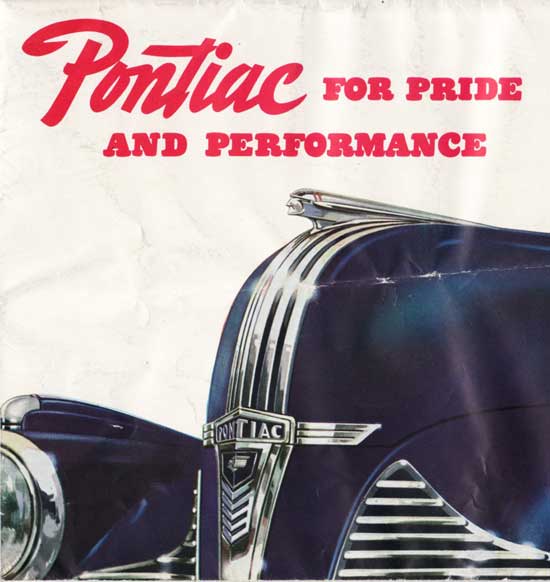
“Pontiac for Pride and Performance” was the advertising slogan in 1940 and it was certainly appropriate. The Torpedo Eight was introduced; the second time in as many years that Pontiac added a new model to their existing product line. Pontiac was able to offer their buyers the choice of a General Motors’ A-, B- or C-body for the first time in history. This put Pontiac on par with Buick and Oldsmobile; and far ahead of their direct competition with regard to the quality and size of the automobiles they offered. The Torpedo Eight was an outstanding value and none of the non-G.M. companies had anything to compare with it at anywhere near the price Pontiac was charging.
The Torpedo Eight rode on a 121.5” wheelbase chassis, (advertised as 122”) with 6.50x16 tires. The straight eight was upgraded with a Carter WDO series 2 barrel carburetor to produce 103 hp @ 3,700 rpm. Torpedo Eights were available only as a 2 door Sport Coupe or a 4 door Touring Sedan, featuring the new for 1940 C-body. They can be readily identified by the rakish 44 degree slant of the windshield, concealed door hinges and the fuel fill hidden beneath a flip-up door on the driver’s side fender. The sedan is a particularly sleek style that eliminated the rear quarter windows for a modern 5 window “greenhouse” as opposed to the traditional 7 window style still in use on the Special and Deluxe sedans. Rear fender panels (fender skirts) were available and often seen in the advertising photos. The rear doors were hinged on the B-pillar and opened at the rear; another distinct feature. Key-lock cylinders on both doors were standard.
The entry level Pontiac was now known as the Special Six and offered 5 models; business coupe, sport coupe, 2 door sedan, 4 door sedan and station wagon. They were all built on a 116.5” wheelbase chassis, (advertised as 117”) and mounted 6.00x16 tires. They featured the small A-body shared with Chevrolet; this was also a new body for 1940. All Special Six models came equipped with full-width, rubber-treaded running boards. They can be visually identified by the fuel fill cap on the passenger rear fender. Another identifying feature of the Special Six is the key-lock door handle. Sun visors, arm rests and dual tail lights were standard equipment on all Pontiacs with Fisher bodies. The station wagon bodies were supplied by the Hercules Body Company of Evansville, Indiana and equipped with a single, side-mount spare tire on the passenger side and single tail lamp as standard equipment. A passenger side tail lamp was optional
The Deluxe Six and Deluxe Eight rode on a 120” wheelbase chassis and mounted the larger B-body shared with the junior series Oldsmobile, Buick and Cadillac. The tire size was the larger 6.50x16, shared with the Torpedo series. The only way to identify a Deluxe Six from a Deluxe Eight from the outside is the hood ornament. The Six is all metal while the Eight features a clear plastic Indian head with stylized feathers set atop the plated metal base. The Deluxe models could be had with full-width running boards like the Special Six or slender, bright-trimmed skirts. Skirt-equipped cars featured heavy rubber gravels guards on the lower front surface of the rear fenders and also rubber gravel guards hung at the rear edge of the front fenders.
The Torpedo Eight rode on a 121.5” wheelbase chassis, (advertised as 122”) with 6.50x16 tires. The straight eight was upgraded with a Carter WDO series 2 barrel carburetor to produce 103 hp @ 3,700 rpm. Torpedo Eights were available only as a 2 door Sport Coupe or a 4 door Touring Sedan, featuring the new for 1940 C-body. They can be readily identified by the rakish 44 degree slant of the windshield, concealed door hinges and the fuel fill hidden beneath a flip-up door on the driver’s side fender. The sedan is a particularly sleek style that eliminated the rear quarter windows for a modern 5 window “greenhouse” as opposed to the traditional 7 window style still in use on the Special and Deluxe sedans. Rear fender panels (fender skirts) were available and often seen in the advertising photos. The rear doors were hinged on the B-pillar and opened at the rear; another distinct feature. Key-lock cylinders on both doors were standard.
The entry level Pontiac was now known as the Special Six and offered 5 models; business coupe, sport coupe, 2 door sedan, 4 door sedan and station wagon. They were all built on a 116.5” wheelbase chassis, (advertised as 117”) and mounted 6.00x16 tires. They featured the small A-body shared with Chevrolet; this was also a new body for 1940. All Special Six models came equipped with full-width, rubber-treaded running boards. They can be visually identified by the fuel fill cap on the passenger rear fender. Another identifying feature of the Special Six is the key-lock door handle. Sun visors, arm rests and dual tail lights were standard equipment on all Pontiacs with Fisher bodies. The station wagon bodies were supplied by the Hercules Body Company of Evansville, Indiana and equipped with a single, side-mount spare tire on the passenger side and single tail lamp as standard equipment. A passenger side tail lamp was optional
The Deluxe Six and Deluxe Eight rode on a 120” wheelbase chassis and mounted the larger B-body shared with the junior series Oldsmobile, Buick and Cadillac. The tire size was the larger 6.50x16, shared with the Torpedo series. The only way to identify a Deluxe Six from a Deluxe Eight from the outside is the hood ornament. The Six is all metal while the Eight features a clear plastic Indian head with stylized feathers set atop the plated metal base. The Deluxe models could be had with full-width running boards like the Special Six or slender, bright-trimmed skirts. Skirt-equipped cars featured heavy rubber gravels guards on the lower front surface of the rear fenders and also rubber gravel guards hung at the rear edge of the front fenders.
The Torpedo Eights offered the same arrangement with regard to running boards or skirts. A key-lock is standard on the passenger front door only; the driver’s lock is optional; the lock cylinder mounts just below the door handle. The Deluxe Six shared its engine with the Special Six while the Deluxe Eight still retained a single barrel carburetor and produced 100hp @ 3,700rpm.
New for 1940, but not exclusive to Pontiac, were sealed beam headlamps. A serious campaign was mounted by the Automobile Safety Foundation to require all manufacturers to adopt the use of the new sealed beam lamps. It standardized the controls, mounting, aiming and the functions of “low” and “high” beam operation. Prior to this there was a wide variety of headlight systems, some of which didn’t provide very much light. Another big advantage of the sealed beam is you get a shiny new reflector as part of the package; with a modular system you only replace the bulb but you won’t restore all of you missing light if the reflector is degraded. The Automobile Safety Foundation provided an information tag shaped like an owl, it hung from the light switch of new cars and offered a rhyme to remind drivers when to use their “bright” lights.
Pontiac raised the compression ratio to 6.5:1 for both six and eight cylinder engines and implemented the use of self-locking connecting rod nuts. New piston pin bushings were utilized and the valve lifters were improved by treating the base with iron phosphate to prevent galling against the lobe. The valve cover plates were improved to prevent oil leaks and a metal gauze screen was installed in the road draft tube to prevent dust from entering the engine when it was shut-off. All 1940 models featured the column-mounted gearshift that Pontiac pioneered 2 years earlier; the transmissions and axles were the same as well. The standard axle ratio was 4.3:1; with a 4.55:1 “mountain” ratio and a 4.1:1 “plains” ratio available factory installed for no extra charge. The 1940 Service Manual makes reference to an available 3.9:1 “economy” axle ratio; which also required the installation of a high compression cylinder head. This is the only reference I can find to this option; although there are gear sets and a high compression head shown in the parts books for 1940.
Pontiac production was up considerably over 1939; the Special series accounting for 106,892 vehicles. The Deluxe Six production was 58,542 and the Eight was 20,433. The new Torpedo Eight series saw 31,224 automobiles produced. Total production was 217,001 of which 165,344 were six cylinder units and 51,657 were eights.
New for 1940, but not exclusive to Pontiac, were sealed beam headlamps. A serious campaign was mounted by the Automobile Safety Foundation to require all manufacturers to adopt the use of the new sealed beam lamps. It standardized the controls, mounting, aiming and the functions of “low” and “high” beam operation. Prior to this there was a wide variety of headlight systems, some of which didn’t provide very much light. Another big advantage of the sealed beam is you get a shiny new reflector as part of the package; with a modular system you only replace the bulb but you won’t restore all of you missing light if the reflector is degraded. The Automobile Safety Foundation provided an information tag shaped like an owl, it hung from the light switch of new cars and offered a rhyme to remind drivers when to use their “bright” lights.
Pontiac raised the compression ratio to 6.5:1 for both six and eight cylinder engines and implemented the use of self-locking connecting rod nuts. New piston pin bushings were utilized and the valve lifters were improved by treating the base with iron phosphate to prevent galling against the lobe. The valve cover plates were improved to prevent oil leaks and a metal gauze screen was installed in the road draft tube to prevent dust from entering the engine when it was shut-off. All 1940 models featured the column-mounted gearshift that Pontiac pioneered 2 years earlier; the transmissions and axles were the same as well. The standard axle ratio was 4.3:1; with a 4.55:1 “mountain” ratio and a 4.1:1 “plains” ratio available factory installed for no extra charge. The 1940 Service Manual makes reference to an available 3.9:1 “economy” axle ratio; which also required the installation of a high compression cylinder head. This is the only reference I can find to this option; although there are gear sets and a high compression head shown in the parts books for 1940.
Pontiac production was up considerably over 1939; the Special series accounting for 106,892 vehicles. The Deluxe Six production was 58,542 and the Eight was 20,433. The new Torpedo Eight series saw 31,224 automobiles produced. Total production was 217,001 of which 165,344 were six cylinder units and 51,657 were eights.

Magazine Ads: We'll Rest our Case Style Setter Torpedo Coupe Hedy Lamarr has a New Car
Full Line Ad Brochure & Accessories Color Chart
Full Line Ad Brochure & Accessories Color Chart

